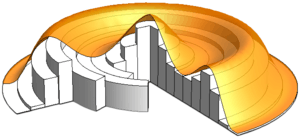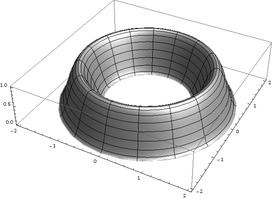Shell integration
Shell integration (the shell method in integral calculus) is a method for calculating the volume of a solid of revolution, when integrating along an axis perpendicular to the axis of revolution. This is in contrast to disc integration which integrates along the axis parallel to the axis of revolution.

| Part of a series of articles about | ||||||
| Calculus | ||||||
|---|---|---|---|---|---|---|
 | ||||||
|
||||||
|
||||||
|
||||||
|
Specialized |
||||||
Definition
The shell method goes as follows: Consider a volume in three dimensions obtained by rotating a cross-section in the xy-plane around the y-axis. Suppose the cross-section is defined by the graph of the positive function f(x) on the interval [a, b]. Then the formula for the volume will be:
If the function is of the y coordinate and the axis of rotation is the x-axis then the formula becomes:
If the function is rotating around the line x = h or y = k, then the formulas become:[1]
and
The formula is derived by computing the double integral in polar coordinates.
Example
Consider the volume, depicted below, whose cross section on the interval [1, 2] is defined by:
In the case of disk integration we would need to solve for x given y. Because the volume is hollow in the middle we will find two functions, one that defines the inner solid and one that defines the outer solid. After integrating these two functions with the disk method we subtract them to yield the desired volume.
With the shell method all we need is the following formula:
By expanding the polynomial the integral becomes very simple. In the end we find the volume is π/10 cubic units.
See also
References
- Heckman, Dave (2014). "Volume – Shell Method" (PDF). Retrieved 2016-09-28.
- Weisstein, Eric W. "Method of Shells". MathWorld.
- Frank Ayres, Elliott Mendelson. Schaum's Outlines: Calculus. McGraw-Hill Professional 2008, ISBN 978-0-07-150861-2. pp. 244–248 (online copy, p. 244, at Google Books)

